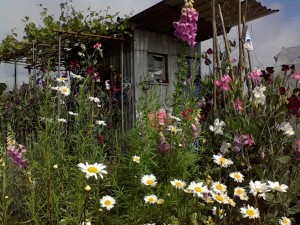
Q. Can Wildflowers be grown successfully on allotments ?
A. Yes it is possible to grow wild flowers very successfully on allotments. As well as looking bright and attractive, there are many other benefits to growing wildflowers on allotments. Many species such as Foxgloves and Teasels attract a wide range of insect predators such as ladybirds that will help control aphid populations and many wild flowers such as Viper’s Bugloss will attract bees thereby improving pollination. Similar benefits can be achieved by the inclusion of log piles, insect houses and allotment wildlife ponds that will attract Frogs, Toads and hedgehogs and help control slug populations without the use of harmful chemicals.
However because soil fertility is generally high on most allotments, a slightly different approach needs to be taken. Rather than attempting to grow a traditional wildflower meadow, it is normally best to avoid the use of meadow grass which would probably grow too vigorously, and simply smoother any wild flowers. Instead it is often best to create a border effect using biennial and perennial wildflower species such as Foxgloves, Oxeye Daisies, Great Mullein, Meadow Cranesbill, Clustered Bellflower, Viper’s Bugloss and Teasels. All of these are strong attractive species that are tall and will compete well with any weeds. We offer these species as individual wildflower plug plants or individual seeds or can supply them in the form of a seed selection for wildflower borders.
Cornfield annual seed mixtures containing species such as Poppies and Cornflowers, can also be grown very well on rich, allotment soils or for longer lasting displays our urban seed mixtures can be sown which contain non-native species such as Californian Poppy. These mixtures can be sown in spring or autumn for quick and easy flowering the following summer but with annual wildflower seeds note that the area will need to be dug over and re-seeded once a year.